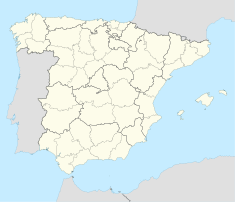
Huesca is a city in north-eastern Spain, within the autonomous community of Aragon. It was the capital of the Kingdom of Aragon between 1096 and 1118. It is also the capital of the Spanish province of the same name and of the comarca of Hoya de Huesca. In 2009, it had a population of 52,059, almost a quarter of the total population of the province. The city is one of the smallest provincial capitals in Spain.

Teruel is a city in Aragon, located in eastern Spain, and is also the capital of Teruel Province. It had a population of 35,900 as of 2022, making it the least populated provincial capital in Spain. It is noted for its harsh climate, with a wide daily variation on temperatures and its renowned jamón serrano, its pottery, its surrounding archaeological sites, rock outcrops containing some of the oldest dinosaur remains of the Iberian Peninsula, and its famous events: La Vaquilla del Ángel during the weekend closest to 10 July and "Bodas de Isabel de Segura" around the third weekend of February.
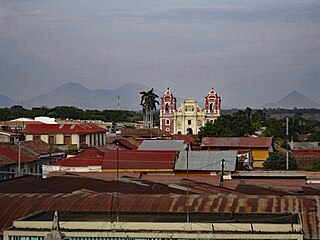
León is the second largest city in Nicaragua, after Managua. Founded by the Spanish as Santiago de los Caballeros de León, it is the capital and largest city of León Department. As of 2022, the municipality of León has an estimated population of 213,718.

Cuenca is a city and municipality of Spain located in the autonomous community of Castilla–La Mancha. It is the capital of the province of Cuenca.

Santa María de Regla de León Cathedral is a Catholic church, the episcopal see of the diocese of León in the city of León, Castile and León, north-western Spain, consecrated under the name of the Virgin Mary. It was the first monument declared by the Royal Order of Spain on August 28, 1844.
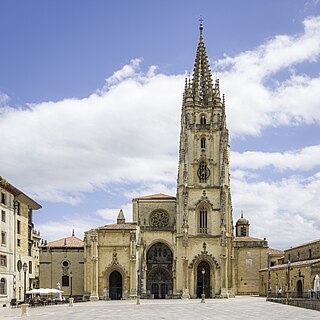
The Metropolitan Cathedral Basilica of the Holy Saviour or Cathedral of San Salvador is a Roman Catholic church and minor basilica in the centre of Oviedo, in the Asturias region of northern Spain.
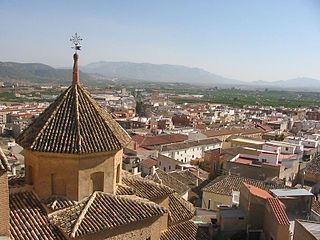
Mula is a municipality of Spain belonging to the Region of Murcia. It is located in southeastern Iberia. It has a total area of 633.84 km2 and, as of 1 January 2020, a registered population of 17,021.

Benavente is a town and municipality in the north of the province of Zamora, in the autonomous community Castile and León of Spain. It has about 20,000 inhabitants.

Cuéllar is a municipality in the Province of Segovia, within the autonomous community of Castile and León, Spain.

Miranda de Ebro is a city on the Ebro river in the province of Burgos in the autonomous community of Castile and León, Spain. It is located in the north-eastern part of the province, on the border with the province of Álava and the autonomous community of La Rioja. According to the 2008 census conducted by Spain's National Institute of Statistics, it has a population of 39,589 inhabitants, making it the second most populous city in the province after the capital, Burgos.

Saint Jerome the Royal is a Roman Catholic church from the early 16th-century in central Madrid (Spain).

Algete is a town and municipality in central Spain. It lies in the comarca de Alcalá in the autonomous community of the Community of Madrid. It had a population of 20,767 in 2022. Algete is 30 kilometres (19 mi) northeast of the capital.

The Royal Basilica of Saint Francis the Great is a Roman Catholic church in central Madrid, Spain, located in the neighborhood of Palacio.

The Cathedral of Sigüenza, officially Catedral de Santa María de Sigüenza, is the seat of the bishop of Sigüenza, in the town of Sigüenza, in Castile-La Mancha, Spain. It was declared Bien de Interés Cultural in 1931.

The Abbey of San Pedro el Viejo is a former Benedictine monastery in the old town of Huesca, Aragon, Spain.
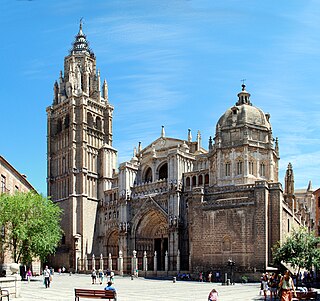
The Primatial Cathedral of Saint Mary of Toledo, otherwise known as Toledo Cathedral, is a Catholic church in Toledo, Spain. It is the seat of the Metropolitan Archdiocese of Toledo.

The Cathedral of Our Lady of the Holy Assumption, better known as Valladolid Cathedral, is a Catholic church in Valladolid, Spain. The main layout was designed by Juan de Herrera in a Renaissance-style.

The Church of San Antón is a Catholic church located in the Old Town neighbourhood of Bilbao, Spain. It is dedicated to Anthony the Great, known as San Antón in Spanish. It is featured, along with the San Antón Bridge, in the city's coat of arms. The estuary of Bilbao flows next to it.

The Church of San Nicolás also known as the church of Church of San Nicolas de Bari, or the Church of San Nicolas de los Servitas, is a Catholic parish church in central Madrid, Spain.

St. Bartholomew's Church is a Catholic religious building in the city of Pontevedra, Galicia, Spain. The church was built in the late 17th century in the Baroque style as a place of worship and pastoral activities for the adjoining Jesuit college. The church was dedicated to Saint Bartholomew when it became a parish church in 1836.

